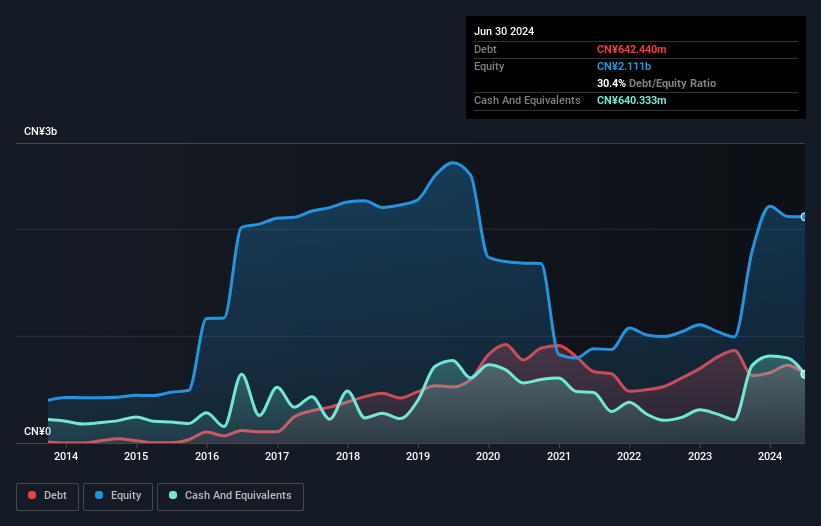Legendary fund manager Li Lu (who Charlie Munger backed) once said, 'The biggest investment risk is not the volatility of prices, but whether you will suffer a permanent loss of capital.' So it seems the smart money knows that debt - which is usually involved in bankruptcies - is a very important factor, when you assess how risky a company is. We note that Kyland Technology Co., Ltd. (SZSE:300353) does have debt on its balance sheet. But is this debt a concern to shareholders?
What Risk Does Debt Bring?
Debt assists a business until the business has trouble paying it off, either with new capital or with free cash flow. In the worst case scenario, a company can go bankrupt if it cannot pay its creditors. However, a more common (but still painful) scenario is that it has to raise new equity capital at a low price, thus permanently diluting shareholders. By replacing dilution, though, debt can be an extremely good tool for businesses that need capital to invest in growth at high rates of return. When we think about a company's use of debt, we first look at cash and debt together.
Check out our latest analysis for Kyland Technology
What Is Kyland Technology's Net Debt?
As you can see below, Kyland Technology had CN¥642.4m of debt at June 2024, down from CN¥862.9m a year prior. However, it also had CN¥640.3m in cash, and so its net debt is CN¥2.11m.

How Strong Is Kyland Technology's Balance Sheet?
Zooming in on the latest balance sheet data, we can see that Kyland Technology had liabilities of CN¥1.20b due within 12 months and liabilities of CN¥291.6m due beyond that. On the other hand, it had cash of CN¥640.3m and CN¥948.5m worth of receivables due within a year. So it can boast CN¥95.6m more liquid assets than total liabilities.
Having regard to Kyland Technology's size, it seems that its liquid assets are well balanced with its total liabilities. So it's very unlikely that the CN¥5.75b company is short on cash, but still worth keeping an eye on the balance sheet. But either way, Kyland Technology has virtually no net debt, so it's fair to say it does not have a heavy debt load! When analysing debt levels, the balance sheet is the obvious place to start. But it is future earnings, more than anything, that will determine Kyland Technology's ability to maintain a healthy balance sheet going forward. So if you're focused on the future you can check out this free report showing analyst profit forecasts.
In the last year Kyland Technology's revenue was pretty flat, and it made a negative EBIT. While that's not too bad, we'd prefer see growth.
Caveat Emptor
Over the last twelve months Kyland Technology produced an earnings before interest and tax (EBIT) loss. Indeed, it lost CN¥69m at the EBIT level. Looking on the brighter side, the business has adequate liquid assets, which give it time to grow and develop before its debt becomes a near-term issue. Still, we'd be more encouraged to study the business in depth if it already had some free cash flow. This one is a bit too risky for our liking. The balance sheet is clearly the area to focus on when you are analysing debt. But ultimately, every company can contain risks that exist outside of the balance sheet. To that end, you should learn about the 3 warning signs we've spotted with Kyland Technology (including 2 which are potentially serious) .
If you're interested in investing in businesses that can grow profits without the burden of debt, then check out this free list of growing businesses that have net cash on the balance sheet.
Valuation is complex, but we're here to simplify it.
Discover if Kyland Technology might be undervalued or overvalued with our detailed analysis, featuring fair value estimates, potential risks, dividends, insider trades, and its financial condition.
Access Free AnalysisHave feedback on this article? Concerned about the content? Get in touch with us directly. Alternatively, email editorial-team (at) simplywallst.com.
This article by Simply Wall St is general in nature. We provide commentary based on historical data and analyst forecasts only using an unbiased methodology and our articles are not intended to be financial advice. It does not constitute a recommendation to buy or sell any stock, and does not take account of your objectives, or your financial situation. We aim to bring you long-term focused analysis driven by fundamental data. Note that our analysis may not factor in the latest price-sensitive company announcements or qualitative material. Simply Wall St has no position in any stocks mentioned.
About SZSE:300353
Kyland Technology
Provides industrial Ethernet technology in China and internationally.
High growth potential with mediocre balance sheet.
Market Insights
Community Narratives



